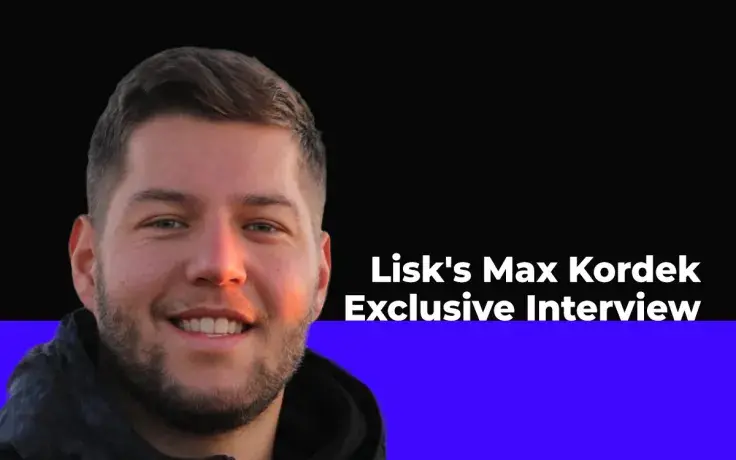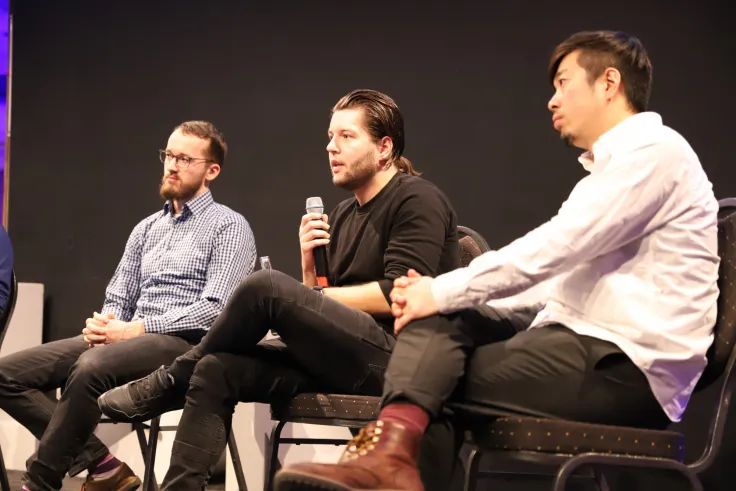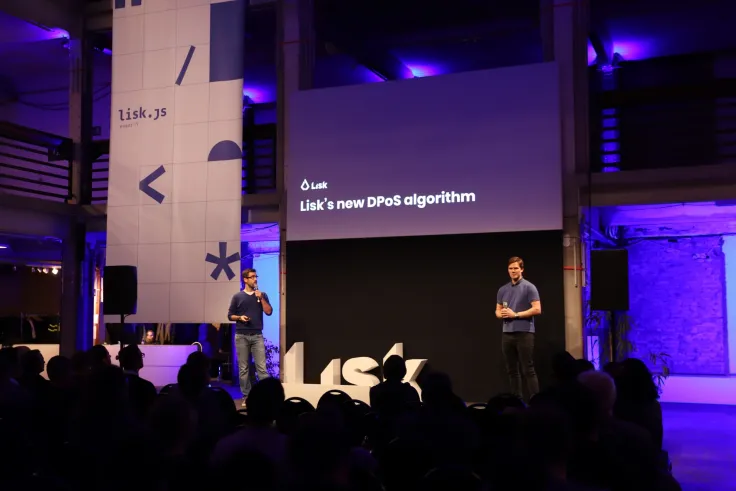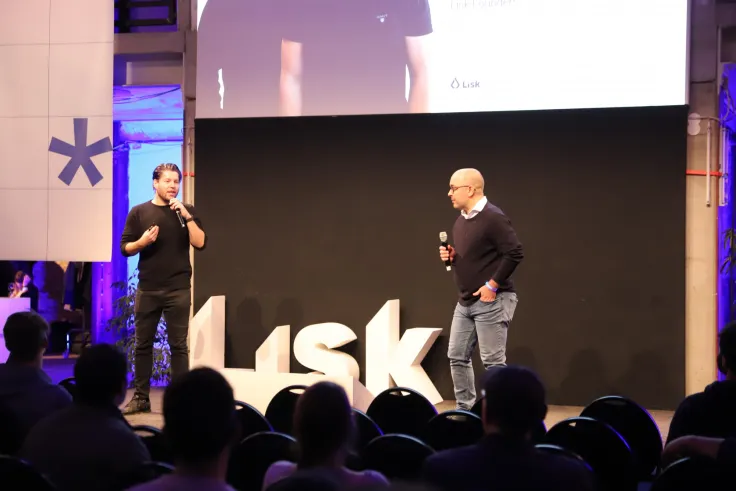
In this conversation with Max Kordek, CEO and cofounder of Lisk, we discuss everything from the beginning of his career in the blockchain sphere to his crypto portfolio. Max also explained all the technical aspects of Lisk’s project in simple terms and shared his views on one of Vitalik Buterin’s recent statements. This was an interesting interview so don’t miss this piece!
U.Today: How did you meet Oliver Beddows, your cofounder at the Lisk Foundation? How did the idea of creating Lisk come to your mind?
Max Kordek: Oliver and I worked together at another blockchain startup for 18 months. The core idea of that startup was to develop tools for developers to build their own blockchain applications. It was a bit similar to Lisk. Oliver and I developed that idea further and we pitched it to the team. But they didn't really want to take this idea on. The funds were dwindling, and the motivation at that startup was at an all-time low. They just didn't want to continue.
We split off from the team and created our own company, called Lisk. The initial idea was born then, basically letting developers easily and rapidly build blockchain applications, connecting these applications to the wider ecosystem of other blockchain applications. It is a network of blockchain applications, which grows more powerful with each application added to it. That's how it all began. It was funny because Oliver and I didn't meet in the real world for the first six months of the company.

Max Kordek. Photo by Lisk.io
We started it in January and the first time we met was in June, in Berlin. By that time, we had already raised all the money, everything was started, the mainnet was live. Our relationship was based on trust as we hadn't seen each other yet or ever met in real life to that point.
U.Today: That's interesting. Do you think your previous team now regrets that they didn't join you on this project?
Max Kordek: Maybe initially, but they all moved on to other projects in the space. It was such an early time, and opportunities appeared left and right. Many of them found these opportunities. I think that, by now, everyone has moved on to other very successful projects.
U.Today: That's good. You are opening a new Lisk center in Berlin in November, and I can see that you are expanding pretty fast. How many people work at Lisk now, and are you going to expand any further?
Max Kordek: We have the Berlin-based blockchain studio called Lightcurve. There, we currently employ 32 people. At the Lisk Foundation, which is based in Zurich, Switzerland, we have four people employed and three board members, which include Oliver and me. It is a total of 39. We shouldn't really grow much beyond 40 people in total because it's just not necessary. With around 40 people, we are well positioned to build our vision. We let quite a few people go at the end of last year.

Lisk's Team. Photo by Lisk.io
We basically cut the team in half, and that caused some aftereffects, in which a few more people left. It was a very positive thing we did for the project, although it was one of the hardest things I've ever done in my life. But the project was basically reborn. The motivation and passion came back really strong. That's why we needed to hire a few more people again to fill a few gaps that came up. Around 40 people is the end goal for the time being.
U.Today: Why did you choose delegated proof of stake (DPoS) as the consensus type for your platform? How do you attract validators?
Max Kordek: In my opinion, delegated proof of stake (DPoS) is the only scalable, secure and proven consensus algorithm on the market today. Regular proof of stake (PoS) or proof of work (PoW) consensus algorithms are not scalable enough in my view, and what the Ethereum Foundation is working on for Ethereum 2.0, i.a. the sharding mechanism, is not real-world proven today. We need something proven and scalable and secure, which is delegated proof of stake.
In summary, at Lisk, we are not here to bring the most cutting-edge technology to the industry. We're here to make blockchain technology accessible, to bring it to the people. That's the most important thing for us, and delegated proof of stake checks all the right boxes in attracting validators. In our case, they're called delegates. That's why it's called delegated proof of stake (DPoS). They just follow the money. There has never been any issue attracting them. It's a real fight to become a delegate in our case. Many people are trying, so there will always be enough delegates who want to secure our blockchain.

Max Kordek. Photo by Lisk.io
U.Today: Can you tell us about Lisk SDK 5.0? What's new about it?
Max Kordek: I think it's best to talk about Lisk Core 3.0. It's super complex in our case; there are so many versions. Lisk Core 3.0 will come with all of the changes of Lisk SDK 3.0, 4.0 and 5.0. SDK is basically this toolkit, these developer tools I was talking about, and Core is the software that creates our network. Our tools are not only for third-party developers. They're also for ourselves. Thus, we are reusing our own tools to build Lisk itself. We have now worked all year on Lisk SDK 3.0, 4.0 and 5.0. They will all be bundled together into Lisk Core 3.0, which will go to our network then.
That will be like our biggest update yet. As far as I'm aware, it will be the biggest update that any running, in production blockchain has ever seen in the world. It's really massive.
Some of the features that Lisk SDK 3.0 will introduce is a new BFT—Byzantine Fault Tolerance—consensus algorithm, which basically cements transactions forever in the blockchain after a certain amount of confirmations. You always have to wait for a certain number of confirmations, because the blockchain can roll back in some cases. But with that feature, in the worst case after 150 confirmations, the transaction is 100 percent cemented in the blockchain forever. That's important later on with interoperability and sending tokens from one blockchain to another; there may be some edge cases where it is very important—including for security reasons.
We also made transactions smaller in size. We can fit more into one block, which is nice for scalability. We made our peer-to-peer network more robust, and we added many more things to SDK 3.0. For SDK 4.0, we introduced a new fee system that will make sending transactions much cheaper and fit more transactions into each block—something the community was asking for for a long time. We also redesigned our multi-signature system, which makes it more secure. It is a much-needed feature for companies that maybe don't trust one individual but would trust a group of people to watch over their money.

Lisk.js. Photo by Lisk.io
The big project that you asked about, which is currently a work in progress in quality assurance, is Lisk SDK 5.0. It introduced a new database, where we moved from something called Postgres to an EmbeddedDB, which comes with about 1000% the speed and scalability and some very complex developer experience-related features. We introduced something called on-chain architecture, which makes everything much more modular and customizable. It is a well-thought-out new feature for the developer experience and also a new ID system for addresses, transactions and blocks for increased security.
All of these changes will be shipped after a successful third-party security audit, and we will have one gigantic update of Lisk Core 3.0. With that update, our blockchain will be totally on a different level, among the top players in the industry in relation to security and scalability.
U.Today: As far as I know, Lisk halving just occurred. Will this affect the community? If so, how?
Max Kordek: The halving happened on Sept. 27, on Sunday evening. Essentially our blockchain started with an inflation of five LSK per block. So, if a delegate, or a validator, creates a new block, then this delegate would get five LSK, and each year it will decrease further. It is truer to talk about a block reward reduction. But on Sept. 27, it decreased from two LSK to one LSK. So, it was our first and last real halving because inflation was cut in half.
To my knowledge, it should not really affect the community. It was the last time that this inflation reduction happened. And of course, now the delegates have less money, and maybe they can support fewer people or projects with that money.
I don't think too much was distributed to projects in the past. It was distributed more to stakers on the network. It just means less inflation and less selling pressure on the markets, which should ultimately be good for traders and for those people who care about the price of LSK. But from now on, every block will incentivize delegates with one Lisk, forever. The effects should not be too visible within the community.
U.Today: Recently Vitalik Buterin claimed that the real throughput of “Ethereum killers” is 100-300 transactions per second. Can you comment on this statement? What about Lisk's bandwidth?
Max Kordek: What Vitalik was saying is that other projects often claim outrageous TPS numbers, and these numbers are just not true. I totally agree with what he is saying; we have seen projects claiming to have 1,000 or 10,000 TPS, and this is just an absolute lie. They're just lying to attract people, like investors, who have no understanding of this topic.
I've checked the numbers. Ethereum has about one million transactions per day, and Bitcoin has around 300,000 transactions per day. Currently with Lisk, we cap it artificially, but with the Lisk Core 3.0 release, we will also have the same bandwidth scalability as Ethereum. This means one million transactions per day. That is just 11.5 transactions per second, but there are so many seconds in a day, which ends up being one million. We will have the same scalability as Ethereum. We have not chosen that number just to be on the same level as Ethereum, but because of the growth of the blockchain itself.

Max Kordek. Photo by Lisk.io
With the same TPS as Ethereum, our blockchain is growing 50 GB a year. We thought that this is a sensible amount of transactions and a sensible blockchain growth. The most used Ethereum blockchain application, Uniswap, had 220,000 transactions today. The difference is that, in the case of Ethereum, all these blockchain applications run on the Ethereum blockchain. In the case of Lisk, they will run on their own blockchain, leaving all other blockchains unaffected by the number of transactions.
Therefore, we can conclude that 1,000,000 transactions per day are more than enough for Lisk for several years to come.
Coming back to the question, in the case of 300 TPS it would mean our blockchain would grow by 1,300 GB each year. In the case of other promises, like 10,000 TPS, it would grow 43,400 GB. This just shows how unreasonable these numbers are.
U.Today: Do you personally have a crypto portfolio? Can you name some of the assets you have—if you have any?
Max Kordek: No, I don't have any cryptocurrencies...
U.Today: Really?
Max Kordek: I am just joking, of course! Since 2012, I have owned cryptocurrencies. I used to have many, but after the big hype in 2018, I scaled it back to the bare minimum, to the essentials. Obviously, I have Lisk—it's the biggest part of my portfolio. Beyond that, I only hold Bitcoin and Ethereum, nothing else. I have a few dollars in some DeFi things to experiment with, a few dollars in stablecoins, but they are just for experimentation. My real portfolio is Lisk, Bitcoin and Ethereum.
U.Today: Can you please explain to me, as a person without a tech mind, what these uninitialized accounts are, why they are less secure than initialized ones and what the case of the 1.6 mln uninitialized LSK accounts is all about?
Max Kordek: From 2016 on, the Lisk blockchain is using quite simple addresses. They are basically just around 20 digits and an easier and shorter representation of the public key. On the other side, there are many, many more possible passphrases, a representation of private keys, in existence. Basically, any letter, digit or symbol of whatever length you can imagine.
That ultimately means that sometimes two different passphrases lead to the same address. That's called a collision.

Lisk's Team. Photo by Lisk.io
Therefore, it's very important that people with LSK inside their accounts conduct one outgoing transaction. Because then the public key, which is the same length as the private key, is being saved on the blockchain and attributed to your account.
The public key has the same length and complexity as the private key, making your account secure to the same degree as on Bitcoin. It is essentially bulletproof. That's why everyone should do one outgoing transaction.
The 1,600,000 LSK account is subject to such a collision attack because it doesn't have any outgoing transactions and therefore no public key added to it yet. That means that any of the passphrases that lead to the same address can retrieve these LSK and, for us, it's impossible to determine who is the rightful owner. The account is from an ICO participant, and we have contacted that person multiple times already. However, we have not gotten a response. The only danger here is that someone gets access to the account and sells the LSK on the market. I believe our markets would sustain such an amount quite well.
This will change with Lisk SDK 5.0.0, in which we are introducing a new address system. So, a fix is already implemented and is being quality assured right now.
U.Today: The last question: Which cryptocurrencies, apart from Lisk, do you find interesting? I believe these are Bitcoin and Ethereum, but maybe you can name some more.
Max Kordek: Obviously Bitcoin, the mother of all cryptocurrency—the digital store of value—has to be at the top of the list. Ethereum is a world computer that people actually develop smart contracts for, unlike other smart contract platforms that no one is interested in. Lisk, of course, is my own baby, which we're working hard on achieving adoption of.
I think the world needs a platform where other developers can build entirely new blockchains and connect them to a wider ecosystem for direct user onboarding and kickstarting into an existing community.
Apart from that, I don't have too much time to do market research. In comparison to Lisk, we basically have two primary competitors—projects that do very similar things to us—Polkadot and Cosmos. Both are working on an SDK for developers to build their own blockchain applications. In the case of Lisk, this one is written in JavaScript. In the case of Polkadot, it's Rust. In the case of Cosmos, it's Go. On the technical side, they are much different, but the vision is similar.
Besides that, I'm not jumping on the DeFi hype right now. For me, it's too early to see anything substantial. I would honestly leave it at that—at the projects that really build tools for developers and innovate the space, which essentially means Bitcoin, Ethereum, Polkadot, Cosmos and Lisk. They are, for me, the best contenders, the best projects out there for the time being.

 Arman Shirinyan
Arman Shirinyan Godfrey Benjamin
Godfrey Benjamin Yuri Molchan
Yuri Molchan Gamza Khanzadaev
Gamza Khanzadaev